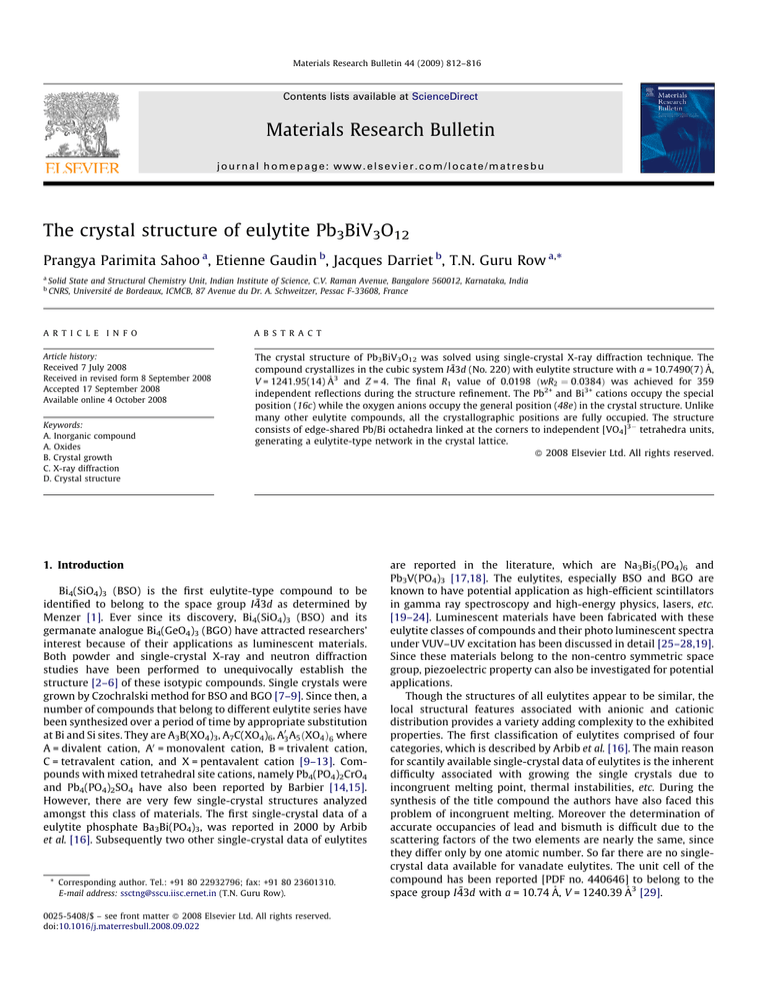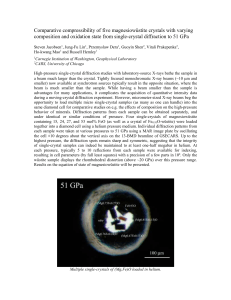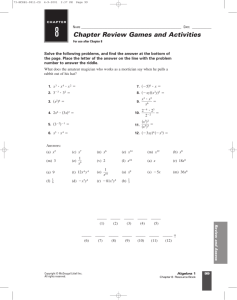
Materials Research Bulletin 44 (2009) 812–816
Contents lists available at ScienceDirect
Materials Research Bulletin
journal homepage: www.elsevier.com/locate/matresbu
The crystal structure of eulytite Pb3BiV3O12
Prangya Parimita Sahoo a, Etienne Gaudin b, Jacques Darriet b, T.N. Guru Row a,*
a
b
Solid State and Structural Chemistry Unit, Indian Institute of Science, C.V. Raman Avenue, Bangalore 560012, Karnataka, India
CNRS, Université de Bordeaux, ICMCB, 87 Avenue du Dr. A. Schweitzer, Pessac F-33608, France
A R T I C L E I N F O
A B S T R A C T
Article history:
Received 7 July 2008
Received in revised form 8 September 2008
Accepted 17 September 2008
Available online 4 October 2008
The crystal structure of Pb3BiV3O12 was solved using single-crystal X-ray diffraction technique. The
compound crystallizes in the cubic system I4̄3d (No. 220) with eulytite structure with a = 10.7490(7) Å,
V = 1241.95(14) Å3 and Z = 4. The final R1 value of 0.0198 ðwR2 ¼ 0:0384Þ was achieved for 359
independent reflections during the structure refinement. The Pb2+ and Bi3+ cations occupy the special
position (16c) while the oxygen anions occupy the general position (48e) in the crystal structure. Unlike
many other eulytite compounds, all the crystallographic positions are fully occupied. The structure
consists of edge-shared Pb/Bi octahedra linked at the corners to independent [VO4]3 tetrahedra units,
generating a eulytite-type network in the crystal lattice.
ß 2008 Elsevier Ltd. All rights reserved.
Keywords:
A. Inorganic compound
A. Oxides
B. Crystal growth
C. X-ray diffraction
D. Crystal structure
1. Introduction
Bi4(SiO4)3 (BSO) is the first eulytite-type compound to be
identified to belong to the space group I4̄3d as determined by
Menzer [1]. Ever since its discovery, Bi4(SiO4)3 (BSO) and its
germanate analogue Bi4(GeO4)3 (BGO) have attracted researchers’
interest because of their applications as luminescent materials.
Both powder and single-crystal X-ray and neutron diffraction
studies have been performed to unequivocally establish the
structure [2–6] of these isotypic compounds. Single crystals were
grown by Czochralski method for BSO and BGO [7–9]. Since then, a
number of compounds that belong to different eulytite series have
been synthesized over a period of time by appropriate substitution
at Bi and Si sites. They are A3B(XO4)3, A7C(XO4)6, A03 A5 ðXO4 Þ6 where
A = divalent cation, A0 = monovalent cation, B = trivalent cation,
C = tetravalent cation, and X = pentavalent cation [9–13]. Compounds with mixed tetrahedral site cations, namely Pb4(PO4)2CrO4
and Pb4(PO4)2SO4 have also been reported by Barbier [14,15].
However, there are very few single-crystal structures analyzed
amongst this class of materials. The first single-crystal data of a
eulytite phosphate Ba3Bi(PO4)3, was reported in 2000 by Arbib
et al. [16]. Subsequently two other single-crystal data of eulytites
* Corresponding author. Tel.: +91 80 22932796; fax: +91 80 23601310.
E-mail address: ssctng@sscu.iisc.ernet.in (T.N. Guru Row).
0025-5408/$ – see front matter ß 2008 Elsevier Ltd. All rights reserved.
doi:10.1016/j.materresbull.2008.09.022
are reported in the literature, which are Na3Bi5(PO4)6 and
Pb3V(PO4)3 [17,18]. The eulytites, especially BSO and BGO are
known to have potential application as high-efficient scintillators
in gamma ray spectroscopy and high-energy physics, lasers, etc.
[19–24]. Luminescent materials have been fabricated with these
eulytite classes of compounds and their photo luminescent spectra
under VUV–UV excitation has been discussed in detail [25–28,19].
Since these materials belong to the non-centro symmetric space
group, piezoelectric property can also be investigated for potential
applications.
Though the structures of all eulytites appear to be similar, the
local structural features associated with anionic and cationic
distribution provides a variety adding complexity to the exhibited
properties. The first classification of eulytites comprised of four
categories, which is described by Arbib et al. [16]. The main reason
for scantily available single-crystal data of eulytites is the inherent
difficulty associated with growing the single crystals due to
incongruent melting point, thermal instabilities, etc. During the
synthesis of the title compound the authors have also faced this
problem of incongruent melting. Moreover the determination of
accurate occupancies of lead and bismuth is difficult due to the
scattering factors of the two elements are nearly the same, since
they differ only by one atomic number. So far there are no singlecrystal data available for vanadate eulytites. The unit cell of the
compound has been reported [PDF no. 440646] to belong to the
space group I4̄3d with a = 10.74 Å, V = 1240.39 Å3 [29].
P.P. Sahoo et al. / Materials Research Bulletin 44 (2009) 812–816
813
2. Experimental
2.1. Materials
Bi2O3 (Aldrich, 99.9%) was dried at 350 8C for 6 h before use.
V2O5 (BDH England, 99.9%) and PbO (Alfa Aesar, 99.9%) were used
as received.
2.2. Preparation and crystal growth
The starting materials PbO, Bi2O3 and V2O5 were taken in the
stoichiometric ratio according to the formula Pb3BiV3O12. The
mixture of the starting reactants was initially ground well with the
help of agate mortar and pestle. The resultant mixture was put for
heat treatment for 2 days at 650 8C in an open platinum crucible.
Minor impurity in addition to the eulytite phase was present in the
resultant product, which did not disappear even on further heating,
as seen from the powder X-ray diffraction studies. Attempts to
quench the sample at various temperature ranges also did not
result in a pure phase. Upon further heating the powder at 800 8C, it
melted incongruently. In order to get the single crystals of the
desired phase, the ratio of the starting materials PbO, Bi2O3 and
V2O5 was changed to 3:1:2 as an alternate expecting the formation
of Pb3BiV3O12 along with BiVO4 which might not melt incongruently at 800 8C. The mixture was put for heat treatment for 2
days at 650 8C. The resulting mass was ground well and
subsequently put for melting at 800 8C for 2 h. Then the melt
was slowly cooled to 650 8C with a rate of 5 8C/h and further cooled
to room temperature. The powder diffraction pattern remained the
same before and after melting the sample. The presence of two
kinds of single crystals was evident under the polarizing
microscope. One being the orange Pb3BiV3O12 and the other one
is the yellow BiVO4 [PDF no. 14-0688] with space group I2/a and
cell parameters a = 5.195 Å, b = 11.70 Å c = 5.092 Å and b = 90.388.
Small orange single crystals of the title compound suitable for Xray diffraction were carefully selected under the microscope.
2.3. Powder X-ray diffraction
Powder diffraction data were collected using a Philips X-pert
diffractometer with Cu Ka radiation over the angular range
68 2u 808, with a step width of 0.028. Le Bail profile analysis in
the JANA2000 [30] suite was used to refine the X-ray diffraction
data. The background was estimated by Legendre polynomial, and
the peak shapes were described by a pseudo-Voigt function
varying five profile coefficients.
The powder pattern having the composition accounting for
Pb3BiV3O12 (before melting) contained a small amount of impurity
along with the cubic eulytite phase. This was identified to be a
derivative of the high temperature g-phase of Pb3V2O8 [32] which
belongs to the space group R3̄m with cell parameters a = 5.7766(3),
c = 20.4666(5). Upon melting, the rhombohedral phase becomes the
dominant phase with BiVO4 as the minor phase. The profile fit of the
sample, before and after melting is shown in Figs. 1 and 2 confirming
the above observations. The reason of getting the high temperature
g-phase of Pb3V2O8 at room temperature could be the stabilization
of the phase by incorporation of Bi at Pb site. However, the
description of the exact composition of the impurity phase and the
mechanism of melting to form new phases are not easily understood.
The second composition with the ratio 3:1:2 resulting in the
anticipated stoichiometric Pb3Bi2V4O16 retain its identity even
after the melting. The polycrystalline sample after melting could be
easily recognized to have two phases, the eulytite phase and the
BiVO4 phase. Fig. 3 describes the profile fit of the sample with the
two phases and there are no uncertainties in these assignments.
Fig. 1. Full pattern matching of the powder pattern of ‘‘Pb3BiV3O12’’ before melting.
The upper and lower rows of vertical marks correspond to the allowed reflections
for g-Pb3V2O8-type and eulytite-type Pb3Bi(VO4)3 compounds, respectively.
Fig. 2. Full pattern matching of the powder pattern of ‘‘Pb3BiV3O12’’ after melting.
The upper and lower rows of vertical marks correspond to the allowed reflections
for BiVO4 and g-Pb3V2O8-type compound, respectively.
2.4. Diffraction data collection
An orange, block-shaped single crystal was selected on
the basis of the size and sharpness of diffraction spots. Data
collection was carried out on an Enraf-Nonius Kappa CCD
diffractometer using a graphite monochromatized Mo Ka
Fig. 3. Full pattern matching of the powder pattern of ‘‘Pb3Bi2V4O16’’ after melting.
The upper and lower rows of vertical marks correspond to the allowed reflections
for BiVO4 and eulytite-type Pb3Bi(VO4) compound, respectively.
P.P. Sahoo et al. / Materials Research Bulletin 44 (2009) 812–816
814
Table 1
Crystallographic data collection and structure refinement of Pb3Bi(VO4)3.
Table 4
Selected bond lengths and bond angles of Pb3Bi(VO4)3.
Empirical formula
Formula weight
Crystal habit, colour
Crystal size (mm)
Temperature (K)
Radiation
Wavelength (Å)
Crystal system
Space group
a (Å)
Volume (Å3)
Z
Density (g cm3)
F(0 0 0)
Scan mode
umax (8)
hmin,max, kmin,max, lmin,max
No. of reflections measured
No. of unique reflections
Absorption correction
m (mm1)
No. of parameters
Refinement
R_all, R_obs
wR2 all; wR2 obs
GoF
Max/min Dr e (Å3)
Bond length Type
Distances (Å)
Bond angle type
Angles (8)
V–O
1.709(5) 4
O–V–O
112.2(2) 2
108.1(2) 4
Pb/Bi–O
2.705(5) 3
O–Pb/Bi–O
71.80(17) 3
82.27(17) 3
82.31(19) 3
115.26(16) 3
151.36(17) 3
Pb3BiV3O12
1175.4
Block, orange
0.032 0.021 0.017
293(2)
Mo Ka
0.71069
Cubic
I4̄3d
10.7490(7)
1241.95(14)
4
6.284
1976
v scan + f scan
31.93
(16,15), (16,16), (16,16)
11,817
359
Gaussian
56.843
15
F2
0.0254, 0.0198
0.0398, 0.0384
1.30
1.02, 0.90
wavelength (lMo Ka = 0.71069 Å) radiation at 293(2) K. The
diffraction intensities were corrected for Lorentz and polarization
effects. Data processing and all of the refinements were performed
with the JANA2000 program package [30]. The shape was
determined with the video microscope of the Kappa CCD and a
Gaussian type absorption correction was applied. Details about
data collection and structure refinement are summarized in
Table 1. The structure was solved using SHELXL-93 program [31]
from 359 independent reflections, having I 3s(I). Atomic
positions of Bi/Pb and V were determined using direct method.
Subsequent difference Fourier synthesis allowed locating the
oxygen atom. The final refinement of the structure was achieved
using a fixed site occupancy ratio 3:1 for Pb and Bi equal to the
ideal values in accordance with the chemical formula Pb3BiV3O12.
The atomic and thermal parameters of bismuth were fixed to be
same as that of lead. The Flack parameter was refined to 0.02(3)
and then fixed to 0. The final residual factors are R1 = 0.0198 and
wR2 ¼ 0:0384. Because of the difference in atomic number of only
one electron, X-ray analysis does not allow us to distinguish
between the atoms Pb and Bi. As evident, neutron diffraction
studies will give better insights into the exact distribution and
coordination of Pb/Bi, however it might be pointed that vanadium
2.308(5) 3
is neutron transparent. Atomic coordinates and isotropic displacement parameters are given in Table 2. Anisotropic displacement parameters (ADPs) and selected inter-atomic distances and
angles are given in Tables 3 and 4.
3. Results and discussion
The general feature of the reported eulytite structure is
described in Fig. 4. This structure does not show any significant
deviation from earlier reported eulytites. The structure consists of
[VO4]3 tetrahedra and Pb/Bi octahedra. While the octahedra share
edges with each other and form a three-dimensional network, the
[VO4]3 tetrahedra share all their vertices with the octahedra.
Figs. 5 and 6 describe these features. As reported earlier [16,17], the
[VO4]3 anionic tetrahedra shows pentagonal channels along
h0 0 1i direction (Fig. 7).
Fig. 4. Three-dimensional view of eulytite Pb3Bi(VO4)3.
Table 2
Atomic coordinates (Å) and isotropic displacement parameters (Å2) for Pb3Bi(VO4)3.
Atomic and Wycoff position
x
y
z
Ueq (Å2)
Occupancy
Pb/Bi (16c)
V (12b)
O (48e)
0.07924(2)
3/8
0.3105(5)
0
0.9636(4)
1/4
0.1174(5)
0.01496 (6)
0.0094(4)
0.0220(16)
1
1
1
Table 3
Anisotropic displacement parameters (Å2) of Pb3Bi(VO4)3.
Atom
U11
U22
U33
U12
U13
U23
Pb/Bi
V
O
0.01496(11)
0.0105(6)
0.032(3)
U11
0.0070(9)
0.017(3)
U11
U11
0.017(2)
0.00146(9)
0
0.005(2)
U12
0
0.009(2)
U12
0
0.0040(18)
P.P. Sahoo et al. / Materials Research Bulletin 44 (2009) 812–816
Fig. 5. View of the structure depicting isolated [VO4]3 tetrahedra.
The bond lengths and angles are consistent with previously
reported distances. All the V–O bonds are identical in [VO4]3
tetrahedra which is equal to 1.709(5) Å. However the O–V–O bond
angles deviate significantly from the regular tetrahedral angle of
109.488 indicating distortion in the tetrahedra. The Pb/Bi sites have
three short distances and three long distances. They are 2.308(5) Å
and 2.705(5) Å for short and long distance, respectively. This
difference between the two sets of distances is explained by the
presence of the lone-pair on Pb2+ and Bi3+. A small difference of the
oxygen surrounding around both cations may explain the
relatively large value of the ADP component U11 of the oxygen
position (Table 3).
815
Fig. 7. Three-dimensional view of eulytite along h0 0 1i showing pentagonal
channels formed by [VO4]3 tetrahedra.
4. Conclusions
As the structure of a vanadate eulytite is not available in the
literature we compare Pb3BiV3O12 with the eulytites already
reported in the literature. The single-crystal structures available
for eulytites till now, suggest diversity with respect to cationic and
anionic sites. The structure is completely ordered in case of BGO
and BSO with one oxygen site, whereas two oxygen sites of
different occupancies have been suggested for Pb4(PO4)2SO4,
Ca3Bi(PO4)3, Ba3La(PO4)3, and Ba3Bi(PO4)3. On the other hand,
three oxygen sites were identified for Sr3La(PO4)3 and Pb3V(PO4)3.
In case of Na3Bi5(PO4)6 one oxygen site and two distinguished
cationic positions were assigned for Na and Bi. Also, in the case of
Pb3V(PO4)3 an unusual feature is the presence of VO6 octahedra
which do not share edges or vertices. In the present study, one
oxygen position is identified while one mixed cationic position for
Pb/Bi is identified. Combination of both neutron and X-ray
diffraction studies would enable us to determine the exact
occupancies of lead and bismuth. Determination of sizable number
of single-crystal structures in eulytite class would probably enable
one to categorize various subclasses in this system.
5. Supporting information available
CIF: the crystal data have been deposited at the Fachinformationszentrum Karlsruhe (FIZ) with the number CSD 419631.
Acknowledgement
PPS thanks LAFICS (IFLACS) for financial support.
References
[1]
[2]
[3]
[4]
[5]
Fig. 6. View of the structure showing edge-shared Pb/Bi octahedra.
G. Menzer, Z. Kristallogr. 78 (1931) 136.
D.J. Segal, R.P. Santoro, R.E. Newnham, Z. Kristallogr. 123 (1966) 73.
A. Durif, M.T. Averbuch-Pouchot, C. R. Acad. Sci. Paris 295B (1982) 555.
P. Fischer, F. Waldner, Solid State Commun. 44 (1982) 657.
S.F. Radaev, L.A. Muradyan, Y.F. Kargin, V.A. Sarlin, V.N. Kanepit, V.I. Simonov, Sov.
Phys. Crystallogr. 35 (2) (1990) 204.
[6] T.I. Milenov, P.M. Rafailov, R. Petrova, Yu.F. Kargin, M.M. Gospodinov, Mater. Sci.
Eng. B 138 (2007) 35.
816
[7]
[8]
[9]
[10]
[11]
[12]
[13]
[14]
[15]
[16]
[17]
[18]
[19]
[20]
[21]
P.P. Sahoo et al. / Materials Research Bulletin 44 (2009) 812–816
J. Liebertz, J. Cryst. Growth 5 (1969) 150.
H. von Philipsborn, J. Cryst. Growth 11 (1971) 348.
K. Fukuda, T. Iwata, T. Niwa, J. Solid State Chem. 179 (11) (2006) 3420.
H. Liang, Y. Tao, Q. Su, Mater. Sci. Eng. B: Solid-State Mater. Adv. Technol. B119 (2)
(2005) 152.
K. Fukuda, H. Matsubara, K. Fukutani, H. Yoshida, Powder Diffr. 19 (4) (2004) 385.
J. Barbier, Can. J. Solid State Chem. 101 (2) (1992) 249.
G.J. McCarthy, D.E. Pfoertsch, J. Solid State Chem. 38 (1) (1981) 128.
J. Barbier, J. Solid State Chem. 101 (1992) 249.
J. Barbier, Eur. J. Solid State Inorg. Chem. 31 (1994) 163.
E. Arbib, B. Elouadi, J.P. Chaminade, J. Darriet, Mater. Res. Bull. 35 (2000)
761.
E. Arbib, J.P. Chaminade, J. Darriet, B. Elouadi, Solid State Sci. 2 (2000) 243.
R.V. Shpanchenkoa, R.V. Panina, J. Hadermannb, C. Bougerolc, E. TakayamaMuromachid, E.V. Antipova, J. Solid State Chem. 178 (2005) 3715.
H.F. Folkerts, J. Zuidema, G. Blasse, Chem. Phys. Lett. 249 (1–2) (1996) 59.
G. Blasse, Chem. Mater. 6 (9) (1994) 1465.
M.V. Lalic, S.O. Souza, Opt. Mater. 30 (2008) 1189.
[22] M. Ishii, K. Harada, Y. Hirose, N. Senguttuvan, M. Kobayashi, I. Yamaga, H. Ueno, K.
Miwa, F. Shiji, F. Yiting, M. Nikl, X.Q. Feng, Opt. Mater. 19 (1) (2002) 201.
[23] T. Znamierowska, W. Szuszkiewicz, J. Hanuza, L. Macalik, D. Hreniak, W. Stre˛k, J.
Alloys Compd. 341 (1–2) (2002) 371.
[24] X.-Q. Feng, G.-Q. Hu, Z.-W. Yin, Y.-P. Huang, S. Kapphan, C. Fisher, F.-Z. Zhou, Y.
Yang, D.-Y. Fan, Mater. Sci. Eng. B 23 (2) (1994) 83.
[25] H. Liang, Y. Tao, J. Xu, H. He, H. Wu, W. Chen, S. Wang, Q. Su, J. Solid State Chem.
177 (3) (2004) 901.
[26] M.F. Hoogendorp, W.J. Schipper, G. Blasse, J. Alloys Compd. 205 (1–2) (1994) 249.
[27] X. Xiao, S. Xu, B. Yan, J. Alloys Compd. 429 (1–2) (2007) 255.
[28] M.J.J. Lammers, H.C.G. Verhaar, G. Blasse, Mater. Chem. Phys. 16 (1) (1987) 63.
[29] R. Ludwig, W. Eysel, Mineral.-Petrograph Institut, Universitaet Heidelberg, Germany, ICDD Grant-in-Aid (1993).
[30] M. Dušek, V. Petřiček, M. Wunschel, R.E. Dinnebier, S. van Smaalen, J. Appl.
Crystallogr. 34 (2001) 398.
[31] SHELXS-97 – A program for automatic solution of crystal structure. G.M. Sheldrick, University of Goettinngen, Germany, 1997, Release 97-2.
[32] J.M. Kiat, P. Garnier, M. Pinot, J. Solid State Chem. 91 (1991) 339.







